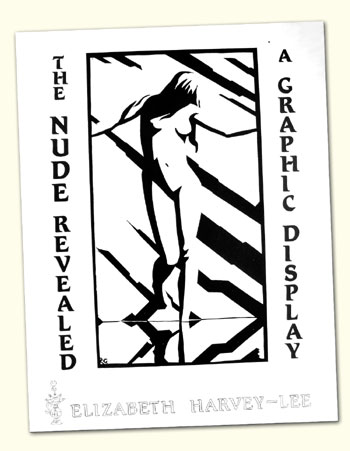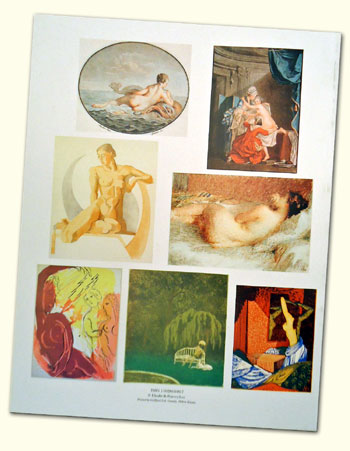|
THE
NUDE REVEALED
 A
'graphic' display A
'graphic' display
The
unclothed human body has inspired many of the greatest
works of art. Central to modern western art since the
Renaissance, the nude is an idiom at once emotive and
aesthetic but at the same time equally expressive of
a wide range of ideas. Images of nudes can be beautiful,
powerful, pathetic, erotic, amusing; and relate to
us all. They contribute to an ongoing dialogue on the
most desirous or expressive relative proportions of
human anatomy; beauty very much in the eye of the beholder.
However, up to the later 19th & early 20th centuries
the classical canon largely held sway.
The
Renaissance rediscovery of classical learning, and
particularly of a literary tradition that put emphasis
on Man, introduced a whole new subject matter to complement
the biblical themes that had dominated in medieval
art. The stories of gods and goddesses whose behaviour
mirrored that of mortals, and tales of heroes who interacted
with the gods, offered an intellectual raison d’être
for eroticism. The examples of antique ideal form and
systems of proportion were an inspiration to depicting
the nude with a glorious plasticity. Venus, in representing
the ideal of female beauty, has lent her name to many
images of the female nude, as has Diana. The types of
Apollo, the ideal of male beauty or Hercules, with his
physical strength expressed through muscular beauty inspired
many images of the male nude. Knowledge of classical
mythology and philosophy were assumed in an educated
audience and old master paintings and prints are full
of narrative details and allegorical allusions both
in their form and content. The nude has also conventionally
served as a direct symbol to express abstract concepts
of truth, virtue, hope, fame, youth, the transitoriness
of life, etc.
Renaissance
thinkers sort to find correspondences between the philosophy
of classical antiquity and the Christian tradition.
This was mirrored in artistic production. Saints such
as Christopher and martyrs such as St Sebastian were
portrayed nude in a Christian equivalent to the classical
hero. Adam and Eve had biblical justification to be
portrayed nude. Eve juxtaposed Venus as an umbrella
title rendering acceptable the depiction, or even the
enjoyment of the representation, of the female nude.
The Old Testament, rather than the New, provided opportunities
for the use of nude models, particularly the Apocryophal
books which relate the stories of Susannah & the
Elders, and David & Bathsheba. These examples of
lecherous voyeurism, with their classical equivalents
in the goddess of the hunt Diana and her nyumphs being
ogled while bathing by satyrs, lent themselves as subjects
for pictures where the viewer is similarly the voyeur.
Printmaking
was developing as an art form just as the major discoveries
of antique sculpture were being made. The ancient Greek
Apollo 'Belvedere' was excavated in Rome about 1479
and would be hugely influential on future generations
of artists, including Dürer who would
have known it second-hand through drawings and prints.
Adam in Dürer’s master print of "Adam & Eve"
is ultimately based on the Apollo 'Belvedere'. Surviving
to a much greater extent than examples of painting, items
of ancient Greek and Roman sculpture, frequently embellished
with nudes or only minimally draped figures, supplied
the models for artists of the Italian Renaissance. Whether
classical or biblical in inspiration the formal language
of the nude came to be based on the canons of antique
sculpture.
With
the establishment of art academies from the 16th century
on, the study of the nude formed the basis of the curriculum.
The student began by copying casts of classical sculptures
and progressed to the life-class (and beyond to the ‘dead’ class
to gain an understanding of the underlying skeletal
frame and muscular structure of human anatomy). In
History Painting, the acme of the hierarchy of artistic
genre, the composition was worked out in preparatory
studies with the figues nude, even if subsequently
clothed in the finished picture.
 Even
in the 19th century and first half of the 20th century,
with Academicism outmoded, overtaken by 'art
for art’s sake', the life-class remained
central to art school education; though in general female
models began to outnumber their male counterparts. In
the popular imagination artists’ models developed
notoriety; the model in the studio became a popular subject.
The classical conventions of bathing nymphs and goddesses
transmuted into straightforward bathers in their natural
environment. However, artists have continued to revisit
the classical and biblical themes initiated by the Renaissance.
Picasso peopled his lithographs with satyrs; Chagall
illustrated the Old Testament in etching and colour lithography;
Eric Gill gave a visual reality through wood engraving
to "The Song of Songs", a biblical erotic theme not commonly
broached by earlier artists. Even
in the 19th century and first half of the 20th century,
with Academicism outmoded, overtaken by 'art
for art’s sake', the life-class remained
central to art school education; though in general female
models began to outnumber their male counterparts. In
the popular imagination artists’ models developed
notoriety; the model in the studio became a popular subject.
The classical conventions of bathing nymphs and goddesses
transmuted into straightforward bathers in their natural
environment. However, artists have continued to revisit
the classical and biblical themes initiated by the Renaissance.
Picasso peopled his lithographs with satyrs; Chagall
illustrated the Old Testament in etching and colour lithography;
Eric Gill gave a visual reality through wood engraving
to "The Song of Songs", a biblical erotic theme not commonly
broached by earlier artists.
Even in the modern stylistic divergence from the academic,
under the influences of African and primitive art which
have altered our conceptions of beauty and proportion,
and in the move towards abstraction, the nude has held
its place as a recurring genre. Hans Bellmer, the surrealist
opined
[the body] is like a sentence which incites us to
disarticulate it, so that through an endless series of
anagrams, its true contents may be combined.
Distortion and abstraction of the human nude figure have
been exploited by artists both for formal and expressive
ends.
In
modern art the nude has remained a principal theme.
It dominates the work of the greatest figures of the
French school, Matisse, Picasso, Chagall; all major
printmakers. It was important to the German Expressionists
group Die Brücke, for whom equally printmaking
itself was an important aspect of their work. It has
informed some of the best of modern British etching,
from Sickert to Lucien Freud, and inspired one of the
icons of Modern British etching, Brockhurst’s
"Adolescence".
The practice of engraving, in directly cutting into
either a sheet of copper or especially into a block of
wood, has a technical correlation with sculpture. Sculptors
have always been particularly concerned with modelling
the nude human figure and when they are printmakers too,
the nude is equally their subject. Though printmaking
was the only artistic medium which Michelangelo did not
practice, his drawings inspired many Renaissance engravers.
In the modern era sculptors have taken to engraving in
significant numbers. Represented in this catalogue are
prints by the sculptors Rodin, Coubine, Hettner, Lehmbruck,
Vieillard, Zadkine, Arnold Auerbach, and Eric Gill and
by sometime sculptors Klinger, Degas, Tissot, Picasso
and Robert Gibbings.
Just
as the human body, though consistent in its constituent
features and overall proportion of its parts, shows great
diversity between individuals, an equally rich variety
of prints graphically reveals the nude over the last
five hundred years. I hope you will enjoy the small selection
offered here in all its different aspects.
Published
2005
80 pages, 180 items described and illustrated in black and white, with seven
in colour on the back cover.
(UK
Price: £10, International orders: £15)
^ Return to the top of this page ^
|
|
Artists
included in the catalogue:
- Aldegrever
H
- Amato
F
- Audenard
R van
- Auerbach
A
- Austin
R
- Bartolozzi
F
- Baudouin
P A
- Béatrizet
N
- Beham
B
- Beham
S
- Belleroche
A
- Binck
J
- Bonasone
G
- Bouverie
Hoyton E
- Bracquemond
F
- Brockhurst
G L
- Buckland-Wright
J
- Cantarini
S
- Carlone
C
- Carracci
A
- Chagall
M
- Charlier
J
- Cipriani
- Collaert
A
- Collaert
J
- Coornhert
D V
- Corinth
L
- Cort
C
- Coubine
O
- Craig
E G
- Crépin
S
- Daglish
E
- Daumier
H
- Davis
W
- Degner
A
- Dillon
H P
- Dolendo
Z
- Domenichino
- Duez
E A
- Dumont
M
- Dunstan
B
- Dürer
A
- Dyck
A van
- Fairclough
M
- Fairclough
W
- Fantin-Latour
H
- Floris
F
- Foujita
T
- Galle
C
- Ghisi
G
- Gibbings
R
- Gill
E
- Goltzius
H
- Greiner
O
- Gromaire
M
- Groome
E
- Haarlem
C C van
- Heckel
E
- Heemskerk
M van
- Heise
W
- Hermes
G
- Hettner
O
- Hill
F
- Hill
V
- Hofmann
L von
- Holroyd
C
- Hudson
E E
- Hughes-Stanton
B
- Ingres
J A D
- Jacquard
A
- Janinet
J F
- John
A
- Jou
L
- Kapp
H
- Kennington
E
- Klinger
M
- Knight
L
- Laboureur
J E
- Larson
C
- Laurent
E
- Lawson
R
- Legrand
L
- Lehmbruck
W
- Lepère
A
- Lippy
- Lucas
van Leyden
- Lurçat
J
- Lyubavin
A
- Maillol
A
- Mander
K van
- Marchand
J
- Maratta
C
- Master
of the Die
- Maetzel-Johannsen
D
- Mellan
C
- Michelangelo
- Michl
F
- Moore
T Sturge
- Mueller
O
- Nash
J
- Neuschul
E
- Nevinson
C R W
- Palma
J
- Peruzzi
B
- Paerels
W
- Pechstein
M
- Perret
P
- Philipp
M E
- Philippi
R
- Philips
- Picasso
P
- Raimondi
M
- Raphael
- Reeve
R
- Regnault
N F
- Rembrandt
- Rodin
A
- Rowlandson
T
- Rubens
- Saenredam
J
- Shannon
C H
- Sims
C
- Sloan
J
- Sompel
P van
- Strang
W
- Strohmeyer
H
- Tissot
J J
- Vaga
P del
- Valadon
S
- Veneziano
A
- Verkolja
N
- Vieillard
R
- Vos
M de
- Whistler
J M
- Wierix
J
- Williams
G
- Zadkine
O
- Zorn
A
Return to the top |